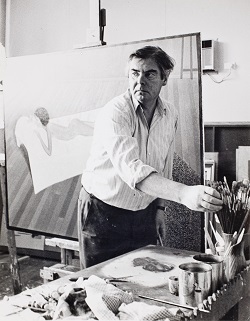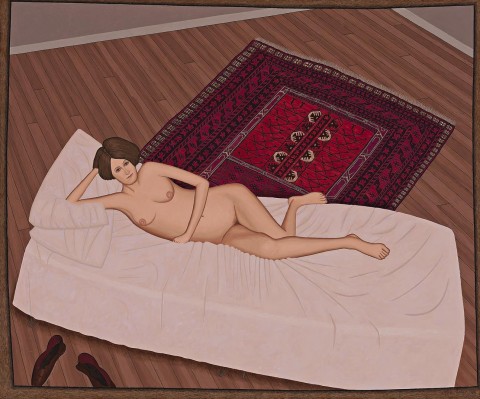RECLINING NUDE, 1980
JOHN BRACK
oil on canvas
127.0 x 153.0 cm
signed and dated lower right: John Brack 1980
inscribed with title on artist’s label verso: RECLINING NUDE
Rudy Komon Gallery, Sydney
Drs Frank and Joan Croll, Sydney
Thence by descent
Dr Joan Croll AO, Sydney
John Brack, Rudy Komon Gallery, Sydney, 16 August – 10 September 1980, cat. 10
Grishin, S., The Art of John Brack, Oxford University Press, Melbourne, 1990, vol. I, pl. 48, pp. 156, 158 (illus., as ‘Recumbent Nude’) & vol. II, cat. o264, pp. 35, 169 (illus., as ‘Recumbent Nude’)
When John Brack embarked on his first sustained series of paintings of the nude during the mid-1950s he was consciously positioning himself within the long tradition in Western art of depicting the naked female body. With characteristic focus and commitment to his artistic growth, he sought to test the development of his work through a return to the rigour and discipline of life drawing and placed an advertisement for a model in the newspaper. His questions about how he might make a new and meaningful contribution to the genre were answered by the single response he received, from a thin middle-aged woman whose appearance demanded a radically different treatment that was far removed from the sensual nudes of earlier artists such as Rubens and Gauguin. Brack quickly realised that ‘there is absolutely nothing whatsoever erotic in an artist’s model unclothed in a suburban empty room’1, and produced a series of striking paintings including Nude in an Armchair, 1957 (National Gallery of Victoria, Melbourne) and The Bathroom, 1957 (National Gallery of Australia, Canberra), that boldly challenged expectations of the subject. While some lamented the skinny, sexless appearance of the model, art critic Alan McCulloch wrote that in pitting himself against tradition Brack had successfully demonstrated that ‘he [was] on all occasions master of the medium’. 2
The nude returned as a major subject within his oeuvre during the 1970s and 80s and in these works, a certain restrained sensuality and pleasure in depicting the female form is apparent. The contrast between the uncomfortable tension of the 1950s nudes and paintings like Reclining Nude, 1980, where the subject looks out at the viewer completely at ease with her nakedness, seems to reflect the changes in social mores that had taken place in the intervening years and the increased informality of the late twentieth century. These differences might also point to the development of Brack’s own confidence and artistic maturity. In the mid-1950s he was at the beginning of his career with a handful of solo exhibitions to his name, still defining his visual language and establishing his artistic persona. In 1968, with the help of a monthly stipend from his Sydney dealer Rudy Komon, Brack resigned from his position as Head of the National Gallery School in Melbourne and for the first time in his life was able to paint full-time. The ensuing decades witnessed regular solo exhibitions, private commissions and the publication of the first monograph on his art.
ARTS001417_RGB.jpg

John Brack in his studio completing
Nude on Shag Rug, 1976–77, February 1977
courtesy of National Gallery of Victoria,
Melbourne
Reclining Nude is typical of the nudes of these decades, depicting the model in a spartan room – a purpose-built studio adjacent to Brack’s house – with its flowing vertiginous floorboards, a richly patterned Persian carpet and in the foreground, a pair of casually discarded shoes (presumably the model’s), which highlight the artifice of the scene. It was in a portrait of his friend, the Melbourne gynaecologist Hal Hattam, painted in 1965, that Brack first incorporated a Persian carpet as a significant element of the composition which also informed its meaning. Inspired by the carpet that covered the floor of his studio – then in a small room behind his office at the Gallery School – Brack used it in this painting to symbolically express an aspect of the sitter.3 A key element of the later nudes, the variously patterned and richly coloured carpets functioned as signifiers of cultural traditions, history and the patterns of civilisation. As Helen Brack has noted, the carpets also represent the world of men4 and in the context of the nudes where the subject is always female this has a particular relevance, pointing to the differences the artist perceived between the sexes and the counterbalance they provide each other.5
Whether he was depicting a familiar suburban scene or a model in the studio, Brack sought to imbue his imagery with layers of meaning beyond the surface, his lifelong aim being to understand and illuminate the complexities of the human condition.6 Helen Brack has described the recurring focus on the nude in his oeuvre as ‘John’s need for discipline in seeing and depicting, and his constant effort to define how women are’.7 Brack’s own statement further clarifies the universality of his ambition: ‘When I paint a woman … I am not interested in how she looks sitting in the studio, but in how she looks at all times, in all lights, what she looked like before and what she is going to look like, what she thinks, hopes, believes, and dreams. The way the light falls and casts its shadows is merely … a hindrance unless it helps me to show these things.’8 Brack typically began with a series of sketches from the model which were worked up into a more finished drawing which, in turn, was used as the basis for the painting and this careful process is reflected in the fine compositional balance, precision and meticulous detail of this painting and indeed, all of his mature work.
Reclining Nude comes from the collection of Dr Joan Croll AO who, with her husband Frank, purchased it from Brack’s 1980 Sydney exhibition. A renowned breast cancer specialist, Croll is the subject of one of the relatively few portrait commissions Brack undertook, and in this 1976 painting – now hanging in the National Portrait Gallery, Canberra – she is depicted sitting in an armchair in the same spare room with another Persian carpet on the floor.
1. Brack, J., interview, Australian Contemporary Art Archive, no. 1, Deakin University Media Production, 1980, transcript, p. 6
2. McCulloch, A., ‘Classical themes’, Herald, 13 November 1957, p. 29
3. See Grant, K., et al., John Brack, exhibition catalogue, National Gallery of Victoria, Melbourne, 2009, p. 110
4. See Lindsay, R., The Nude in the Art of John Brack, exhibition catalogue, McClelland Gallery and Sculpture Park, Victoria, 2007, unpaginated
5. See Helen Brack quoted in Gott, T., A Question of Balance: John Brack 1974 – 1994, exhibition catalogue, Heide Museum of Modern Art, Victoria, 2000, p. 23
6. Grant, op. cit., p. 87
7. Brack, H., ‘This Oeuvre – The Work Itself’, Grant, K., op. cit., p. 16
8. Brack, J. quoted in Grishin, S., ‘The nudes of John Brack’, John Brack (1920-1999): A Tribute Exhibition, exhibition catalogue, Rex Irwin, Sydney, 1999, unpaginated
KIRSTY GRANT
